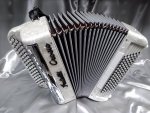is now marjd NickC pid=71832 dateline=1588702490 said:
I came across a few nice looking Fratelli Crosio CBAs from this site
https://atelier-accordage.fr/occasions
They look like nice instruments.
I was able to find another ad, which is suggesting that they were made by Beltuna?? Does anyone have any info about these instruments?
https://reverb.com/item/28583220-fr...prestige-2000-ampli-sound-2005-glittery-black
Both sites are appear to be in French, so maybe its made for the French market??
Nick,
Both accordions were indeed made for the French market, and Ill attempt to explain, in less than 11,000 words.
The first instrument is now marked as sold in the shop listing. Fratelli Crosio made instruments of very high quality for the French market for many years, and for a time they were the go to brand for musette players. They opened up a factory in Paris that ran between dates I can no longer remember. The info will be on the web somewhere, but might take a bit of finding. Basically they assembled and/or distributed accordions and parts that were made in Crosios main workshop in Castelfidardo, Italy. They also acted as a repair and tuning shop for accordions sold in France. The history is a bit vague, but when the backside fell out of the French market they pulled out and moved the whole show to Castelfidardo. Almost immediately they did so, a lot of French pro players took that as a slight on them, and refused to buy them, citing that the quality had declined since the Paris closure.
As far as I can remember Crosio closed the Castelfidardo operation down in 1994.
That first instrument has the look of having been one of the latter ones to have been made in Paris, although I wouldnt put money on it. It is a pure French box, with 3 voices LMM (no cassotto), and the couplers are behind the treble buttons. Note the mushroom bass buttons on the stepped bass keyboard, and lack of bellows straps, two other French peculiarities.
The bass buttons are listed as 3/3 (three rows of single bass notes on the inside with only major, minor, and 7th chords. There is no dim7 row on a standard French accordion).
Please also note the instrument has only 4 rows of treble buttons. One other thing that is not so obvious is that French CBAs have smaller than normal treble buttons. There are reasons for that but Ill keep it simple for now. Standard tuning will be the second M to be about 8 cents up on the straight M reeds, and if it makes any difference to you the diapason will likely be 442Hz, compared to standard UK diapason of 440Hz. That means your straight M is already 8 cents up from anybody elses UK accordion, and the high M will typically be 16 cents up. If no other accordions involved it wont matter too much, although string players may need to tune up to match your accordion.
That is as good an instrument as youll get, but the reeds will be nailed on cork or calf leather (yes really) and the box will have a brighter tone than a box with waxed reeds as a result.
If you havent given up reading by now well move on to the black accordion. LLMM with two LLs and one of the Ms in a tone chamber. Were getting very technical now, and if Im totally honest, Ive never played such a beast. It is usually possible to switch one of the Ls out of the tone chamber, and one of the L reeds may effectively be a double bassoon tuned an octave below the other L. The M reeds will most likely be fairly close together, maybe 4 cents or even less, as that box was made for modern jazzy French music.
I was unaware of any connection between Crosio and Beltuna, and the latter name is not even mentioned in the French language version of the listing. Thats not to say there wasnt any connection, its just that I wasnt aware of it. Castelfidardo is a bit confusing. If you can imagine Fiats, Alfas, Ferraris, and Lamborghinis all being made by the same guy in his back yard, until one of them decided to use his brother to make wheels on Mondays, Wednesdays and Fridays, and his mothers uncle to plug the gaps on other days, that is the best description I can offer. Only people who actually live and work there usually have any real idea of who makes or made what.
Craftsmanship second to none by people who live sleep and eat accordions gives us another superb instrument, again made for the French market with all the same techy bits as its neighbour, except that it has 5 rows. Why LL? To be honest youd need to hear it to understand why, and Ive been told that the issue of keeping two sets of bassoon reeds in tune with each other are vital in such an instrument, for reasons I dont completely understand. Basically, if it goes wrong, youre on a trip to France to a tuner who knows what to do with it, or go to Castelfidardo and bang a few doors until you can get somebody who knows what to do to put it right.
Ive just noticed that the second photo you have posted is of an older blue Crosio similar to the white one, and hope I havent confused you by speaking about the one in your link, which features the black LLMM box?
In summary Crosio is a great make and you wont go wrong, assuming all the bits and pieces are in good nick, and have been well maintained.
That was the short version!
EDIT:- Crosios Italian factory was in Stradella, not Castelfidardo. Memory failure on that one!




